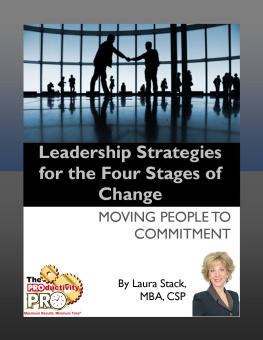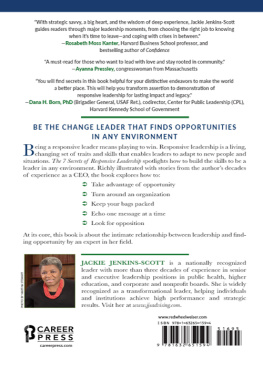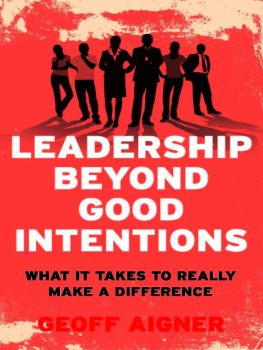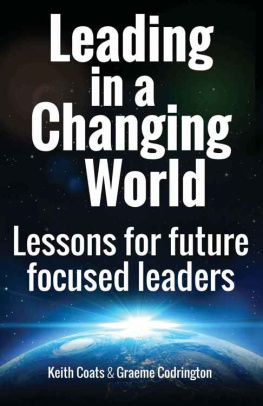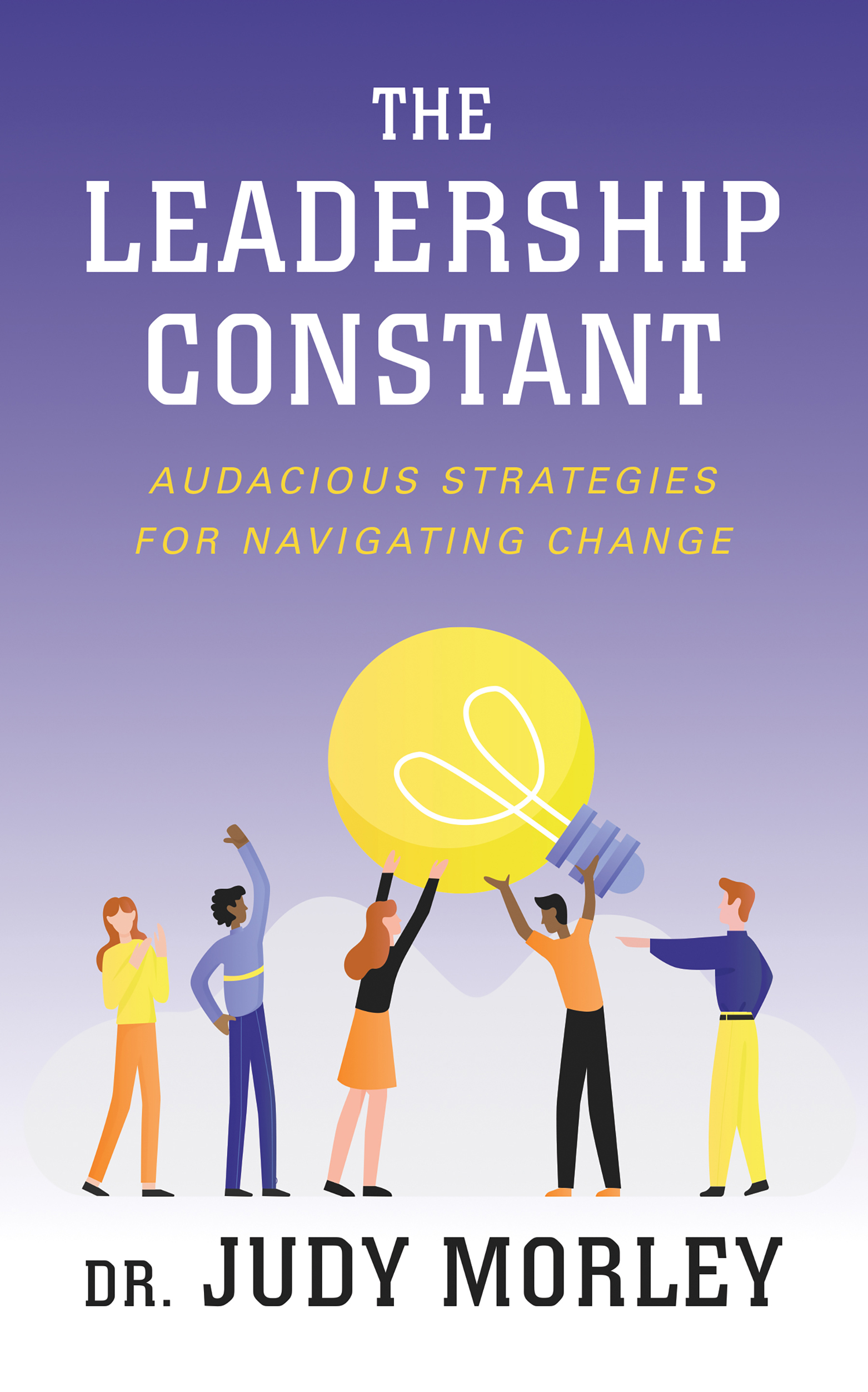Contents
Guide
Pagebreaks of the Print Version
Also by Dr. Judy Morley
_____
5 Spiritual Steps to Overcome Adversity
THE LEADERSHIP CONSTANT
AUDACIOUS STRATEGIES FOR NAVIGATING CHANGE
. JUDY MORLEY


Published 2022 by Gildan Media LLC
aka G&D Media
www.GandDmedia.com
THE LEADERSHIP CONSTANT. Copyright 2022 by Dr. Judy Morley. All rights reserved.
No part of this book may be used, reproduced or transmitted in any manner whatsoever, by any means (electronic, photocopying, recording, or otherwise), without the prior written permission of the author, except in the case of brief quotations embodied in critical articles and reviews. No liability is assumed with respect to the use of the information contained within. Although every precaution has been taken, the author and publisher assume no liability for errors or omissions. Neither is any liability assumed for damages resulting from the use of the information contained herein.
FIRST EDITION 2022
Front cover design by David Rheinhardt of Pyrographx
Interior design by Meghan Day Healey of Story Horse, LLC
Library of Congress Cataloging-in-Publication Data is available upon request
eISBN: 978-1-7225-2713-6
10 987654321
Contents
Rethinking Transitions
Change is inevitable, except from a vending machine.
ROBERT GALLAGHER
Greek philosopher Heraclituss famous statement about change being the only constant is as true today as it was 2,500 years ago. This may not be good news for most people. Humans have been conditioned to dread, fear, and avoid changes. Throughout human history, however, changes have always brought benefits. No growth, evolution, or advancement happens without change. The evolution of social structures, businesses, governments, and institutions throughout the millennia show that change has, indeed, been constant. Moreover, change has been the driving factor behind all progress.
Change itself is neither inherently good or bad. All things are in fluxwhether the rapidly multiplying cells of the body, changing seasons, shifting weather, or trending cultural movements. Everything is either growing or dying. All technological, cultural, and intellectual advancements stem from a constant energetic flow of change.
As prevalent as change is, human beings are inherently uncomfortable with it. For something so fundamental, it is paradoxical and yet axiomatic that people resist it. The reasons for resistance include biological, psychological, and cultural factors.
First, humans biological makeup strives to maintain the status quo. To survive, bodies seek homeostasis, which is the state of remaining the same. On the macro level, homeostasis gives the illusion of inertia. However, it is not the absence of change, but actually thousands of tiny changes happening so rapidly that they appear to be unmoving. Regardless of whats happening beneath the surface, all appearances point to business as usual.
Additionally, human brains are wired to prefer repetitive tasks. The basal ganglia, located in the most primitive parts of the brain, enable people to perform routine tasks with minimal energy. This survival mechanism is the reason you can push a grocery cart, talk on a cell phone, avoid other shoppers, and solve a problem at work while still breathing and blinking. The basal ganglia ingrain habits so that much of your life happens on autopilot. If youve ever driven home from work and not remembered doing it, you know what I mean. All this biological programming seems to keep us in a rut.
Psychological factors also contribute to the human resistance to change. Comfort zones create the situations, attitudes, and sometimes physical places that feel safe, familiar, and calming. Comfort zones are a way to make sense of changes in life, creating almost- mechanistic processes to get through day-to-day existence. Parents frequently create routines for children to help them feel secure, from brushing teeth to bath time to bedtime stories.
Once you grew up, you probably not only continued these routines, but you also created more. Whether you are driving to work the same way every day, doing chores, or figuring out relationships, your comfort zones provide the feeling of mastery over your environment. The familiarity is a cornerstone to mental health and a sense of well-being.
Third, cultural factors provide barriers to change. Although Americans claim to value innovation, most prefer the status quo. Culture changes slowly, and although each generation thinks they lead a cultural revolution, each so-called revolution is ultimately coopted into the prevailing culture. No generation has a monopoly on either virtue or vice. Sexual promiscuity, violence, and the perception of decaying values are common to every era.
In the twentieth century, technological innovation masked the slow pace of cultural change. Penicillin, space travel, television, personal computers, and mobile phones gave the illusion of innovation, while racism, misogyny, xenophobia, and paternalism persisted. Lasting cultural innovations are rare. Conservative cultural forces rely on nostalgia for a past that never was, to slow the pace of cultural change.
Despite all these resistant factors, change happens. Sometimes humans instigate it, hoping for something better. More frequently, people are thrust into transitions against their will. Although the first kind of change seems like a welcome event, a long period of adjustment still occursalmost a grieving process for the past thats been left behind. If a change comes quickly from an outside force, however, it feels frightening and overwhelming. It takes time to process the emotions and adapt to a new environment with a new set of rules.
Therapists advise against making major life decisions after a significant change, such as starting a different job, moving to a new home, or losing a loved one. They understand that change upsets the cognitive faculties and causes stress that leads to mistakes and poor judgment.
Leadership in a Changing Organization
As difficult as change is for individuals, the level of complexity is multiplied in organizations. Rapidly changing conditions provide specific challenges to leadership. If you have picked up this book, you are probably looking for a way to lead an organization, team, or community through a time of transition. Each individual within a company must go through their personal process of adapting to change, while structures and procedures must also be evaluated, modified, or overhauled.
As with people, organizational adaptation takes place whether the change is positivesuch as occurs with an expansion or new productor negative like layoffs or a takeover. Organizational leaders must perform a particularly tricky juggling act to be empathetic to individuals adapting to the new circumstances while also creating new policies and procedureseven as they continue to do business as usual.
In his classic book Good to Great, author Jim Collins talks about the organizational tension brought on by changes. According to Collins, any time an innovation occurs, a company must balance between preserving core values and stimulating progress. Core values are the cornerstone of every business identity and need to be honored and preserved.


